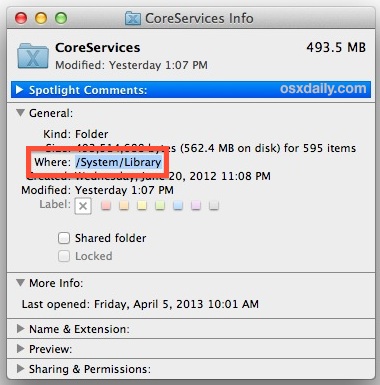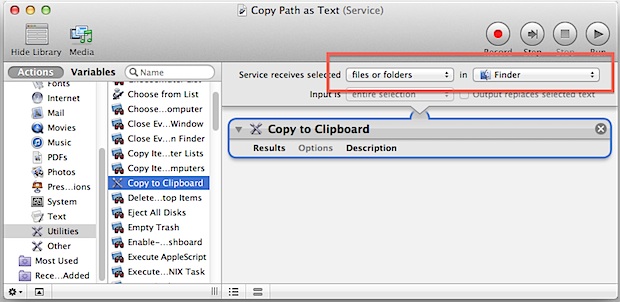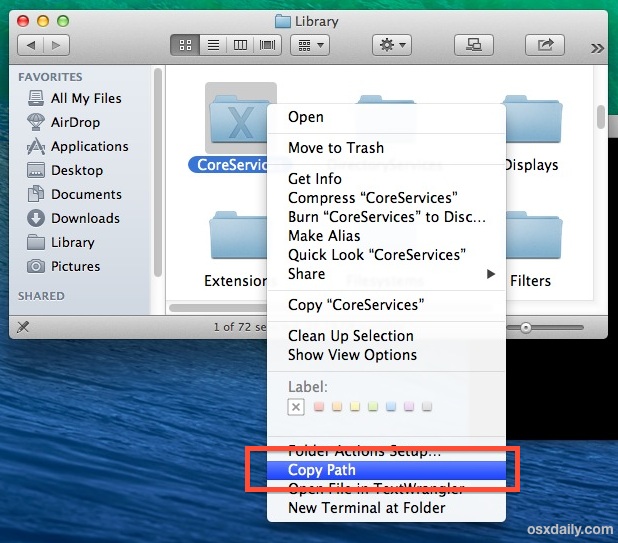There are a few ways to retrieve a file or folders full path from Mac OS X, and we’ll cover the two easiest methods here, and also a third option that utilizes a Service to instantly copy any path to the clipboard. First, we’ll use the Get Info panel to pull any items complete path, and then we’ll use another trick that utilizes an under appreciated feature of the Terminal to retrieve any directory or files path. The optional Automator Service provides yet another option to copy file and folder paths, which is then quickly accessible through the right-click menu from the OS X Finder.

Just to clarify, we are looking to copy the path to a file or folder to the clipboard so that it can be pasted elsewhere. This is different from showing the path, which can be made visible in any Finder window through an optional window bar or even in the title bar using a defaults trick.
Let’s get to copying complete paths so that you can use them elsewhere.
Copy a File / Directory Path from the OS X Get Info Window
Perhaps the easiest and most user friendly method, you can easily retrieve any file or folders path from the Get Info window by doing the following:
- Select the file or folder in the OS X Finder, then hit Command+i to summon Get Info
- Click and drag alongside “Where” to select the path, then hit Command+C to copy the full path to the clipboard

Get Info can also be accessed by the control-click and right-click menus. For most use cases and for occasional complete path access, the Get Info trick is simple, fast, efficient, and should fit the bill for most people.
Print Path through the Mac Terminal
Dragging and dropping anything into the OS X Terminal outputs the full path to that item.
- Launch Terminal then drag and drop any item from the Finder into the Terminal window to instantly print the full path
- Select and highlight the path to copy it to the clipboard as usual

This trick is great if you are looking to use the path in the Terminal, otherwise it may not be as easy as the Get Info tip because it requires opening another app.
Create a “Copy Path” Service for the Right-Click Menu
If you find yourself frequently needing to copy and paste file and folder paths, creating an Automator Service will make your life easier because the service then becomes accessible from the OS X Right-Click contextual menu, accessible from anywhere in the Finder. This is an excellent trick from CNet and is very easy to set up yourself:
- Launch Automator and create a new “Service”
- Use the search function to look for “Copy to Clipboard” and drag that into the rightside panel of the Service
- Set ‘Service recieves selected’ to “files or folders” and ‘in’ to “Finder” as shown in the screen shot below
- Save the Service with a name like “Copy Path”

Now go anywhere in the Finder, select anything in the filesystem be it a directory or a file, then right-click to reveal the “Copy Path” service item as created.

Choosing that option will instantly copy the chosen items path to the clipboard, which you can then paste elsewhere.
What is a path anyway?
For the unfamiliar, you can think of an items path as it’s address in the file system, pointing to exactly where it resides on the computer. For example, a file named “Testfile.txt” that resides on your user account desktop would have a complete path that would resemble something like this:
/Users/USERNAME/Desktop/Testfile.txt
For items in the user directories, you can user a tilde to shorthand the path like so:
~/Desktop/Testfile.txt
That shorthand does not work with system files, or for accessing other user files, thus a complete path would be needed. All of the methods we’re sharing will access and copy the complete path, not the short hand, even if the file or directory in question is in the user folders.
source

Post a Comment